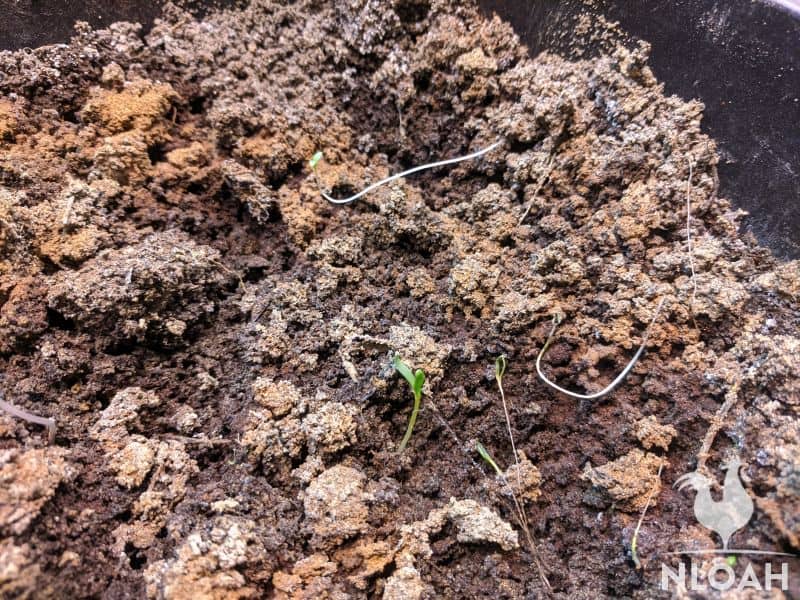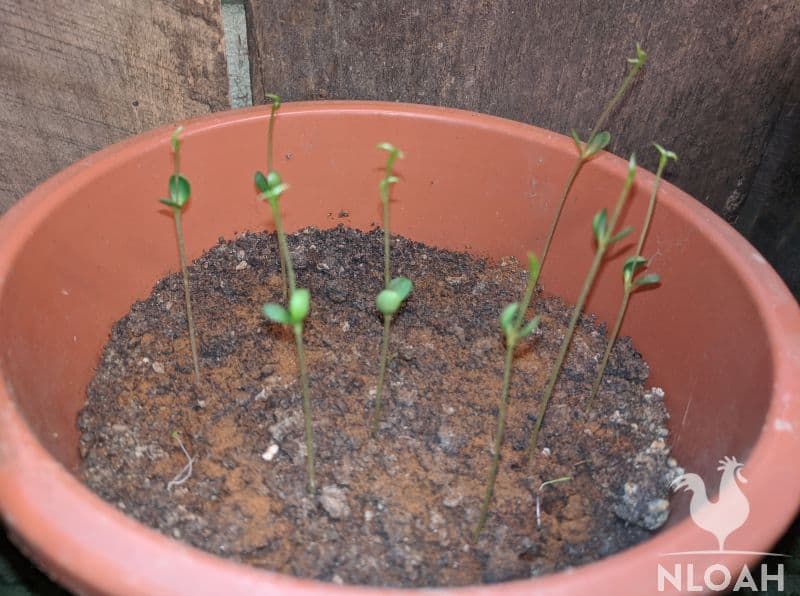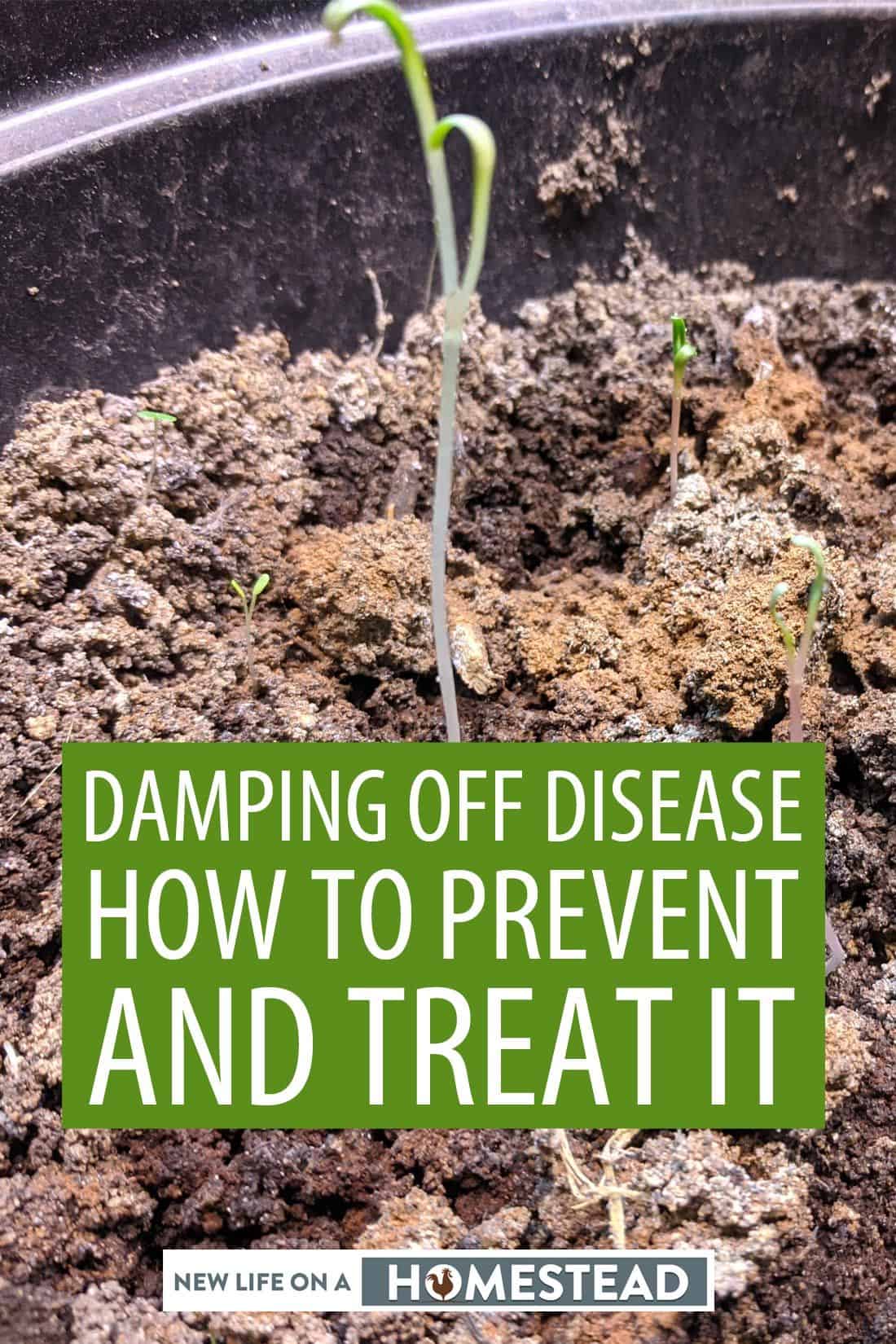Damping off is a plant disease that develops from fungi or bacteria in the soil. Also commonly referred to as “dampening off” this crop disease almost exclusively afflicts only seeds and the newly sprouting plants they yield. Damping off disease typically targets vegetable plants and flowers, not fruit crop seeds.
Damping off disease causes the rotting of both the root and stem tissues of seeds and newly sprouted seeds. The initial phase occurs below the surface of the soil – allowing it to grows undetected until it is almost too late to thwart it.
Older or more developed young plants that become afflicted with damping off disease rarely die from the fungal disease because the protective layer on their secondary stem tissues creates a barrier between the plant and attacking fungal spores. If a started plant is killed by damping off disease it is typically crown rot or root rot that cause its expiration.
Seeds that develop damping off disease usually burst through the surface, and initially look healthy. But, it takes only a coupling of days for the sprouts to turn “mushy” fall over – and die.
Sometimes the sprouting plants grow tall and spindly before turning mushy. If this happens, you have a window (albeit a short one) to attempt to save the sprouts.

In the photo above you can see how thin the stem of the sprouting seeds are once damping off takes hold. The lack of a solid and healthy stem structure ultimately causes the young plants to fall over.
What Causes Damping Off?
Sometimes damping off disease is caused by just one factor, but in many cases it could be a combination of issues that create an environment where the deadly plant disease can grow.
Soil Fungus
There are several different types of fungus that can cause damping off in seeds, and in sprouting plants:
- Pythium
- Phytophthora
- Rhizoctonia
- Fusarium
The pythium species of soil fungus is typically the most common culprit for causing damping off disease.
Soil Conditions
Damping off disease occurs most often when seeds are planted in wet and cold soil. The chances of this plant fungal disease are increased if old or improperly stored seeds are planted.
If the soil is poor draining by nature or not enough drainage holes are placed in the planter or seed starting cells, the likelihood of damping off disease development increases substantially.
Humidity
If the seeds are planted too deeply down in the soil and they are growing in a high humidity environment, damping off can also be caused.
The moisture levels in the soil increases substantially in such conditions, and can also cause the rotting of seeds and the development of bacteria or fungi.
Fungal Spores
Fungus spores live in the dirt, and are often a problem in seed beds, especially those that are left filled and outdoors year round. The spores are fairly easily transported into healthy planters and onto garden tools.
If planters and seed starting trays are left outdoors or stored in an unheated garden shed or garage, they are more likely to retain the spores, and spread them into a greenhouse or indoor seed starting table.
Garden Soil
Some folks who have struggled with damping off disease when starting seeds in their house or in a greenhouse attempt to start the seeds later in garden soil outdoors to avoid losing plants to damping off disease.
Such a plant fungal disease avoidance measure may or may not work. Garden soil can also contain small portions of the fungus that causes damping off.
This is also why digging up some dirt from the garden to start seeds (because it was a quality soil during the previous growing year) can be a recipe for disaster.
Over the course of the fall and winter the once quality soil could experience the growth of fungal spores, especially if the weather was unusually cold and precipitation was high.
By the time the last threat of frost has passed, and it is warm enough to put plants in the ground, the garden dirt will usually have had time to warm up and dry out from the fall and winter seasons.
But, when the dirt from the growing plot is shoveled up to cultivate seeds in January or early February, it is still cold, damp, or humid enough for damping off fungal spores to remain present and active.
When using garden soil or any soil that has been stored outdoors and exposed to the elements to start seeds, bring it inside and allow it to dry out and warm up for several days to a week before planting the first seed in it.
Taking the time to do this simple step could mean the difference between growing enough plants to have a full and robust harvest, and having to rush to a garden center and spend money on already established plants to put in the homesteading garden.
Other Damping Off Disease Causes
Although the damping off disease causes noted above are the primary ways the fungal spores develop and spread, other growing environment issues can also lead to this deadly disease.
Basically, any growing condition, natural or man-made, that stunts the growth of the seed or the sprouting plant, can cause damping off disease. If you over-water your seeds, attempt to grow them in low light conditions, over fertilize them, or simply are using healthy but cold soil, damping off can develop.
Damping Off Disease Symptoms
- Seeds that do not sprout in all but dry soil.
- The first leaves that grow on the seedlings (cotyledons) and the young stems are soft, appear water soaked or mushy, or are a distorted color – typically a shade of gray to brown.
- The stems on the sprouting plants are incredibly thin, and also appear water soaked.
- The leaves on plants afflicted with damping off disease will typically wilt and turn from a lush and healthy shade of green to brown.
- If any roots are still present on a sprouting plant that has damping off disease, they will usually be smaller than normal due to stunted growth and feature brown or gray sunken spots.
- A white growth that can appear to resemble cobwebs can also appear on sprouting seeds and plants that are experiencing damping off disease due to high humidity levels.
The photo below shows some recovered pear sprouts after contracting damping off disease. I was able to catch the fungal disease at the first sign of damage and correct it by infusing more heat into the soil and sprinkling cinnamon onto the surface.

Damping Off Disease Cure?
Many gardeners staunchly maintain there is no cure for damping off disease. In my personal opinion, they are almost absolutely correct. I have been able to save some sprouting seeds or young plants from damping off disease by infusing cinnamon and chamomile into the soil.
There are many chamomile and cinnamon tea recipes floating around on the internet as a damping off disease preventative. When I woke up one morning and had an entire tray of pear and echinacea seeds suddenly in the midst of a fungal spore attack, I decided to give the tea a shot.
I was going to have to pitch the entire tray of seeds anyway, so I figured it would hurt nothing to give it a shot. Fruit plants are not typically afflicted with damping off, but there are always exceptions to any rule, hence the fungal spore disease my pear seeds developed.
I used a cinnamon and chamomile tea recipe that I tweaked slightly on half of tray, sprinkled a lot of cinnamon directly onto the soil surface, and gently stirred it into the dirt between the plants in the other half of the tray.
Roughly half of the sprouted seedlings were saved from damping off disease. The little plants that had been subjected solely to the sprinkled and stirred cinnamon did the best. Now, these plants did not produce a robust yield, but they did survive and produce a crop.
Cinnamon and Chamomile Tea Recipe
Ingredients
- 2 pinches cinnamon
- 1 tablespoon 3% hydrogen peroxide
- 1 quart water lukewarm
Instructions
- Brew the tea with the recommended mixture of water for making three bags of tea.
- Pour the tea into a squirt bottle once it has cooled enough to do so safely.
- Pour in the hydrogen peroxide.
- Place the squirt bottle lid firmly on the bottle, and shake vigorously for about 30 seconds.
- Mist the sprouting seeds or plants with the spray. Do not overly dampen the seeds with the tea solution. Instead, coat them with the spray as you would if watering a slightly dry plant.
- Coat the surface of the soil with the cinnamon – not the plants themselves.
- Turn the cinnamon over into the soil gently with a spoon so as to not disturb the fragile sprouts.
The tea spray may need to be repeated every two days to save the plants. This same recipe can be used to protect healthy sprouted seeds from becoming afflicted with damping off and to treat the soil to thwart any fungal spores before using it for planting.
Preventing Damping Off Disease
The best way to prevent the loss of plants from damping off disease is to stop the fungal spores from growing or spreading in the first place. Once the disease appears, it will spread from plant to plant rapidly because it is a soil borne fungus.
These echinacea seed sprouts are also struggling with damping off disease. The heat pad beneath the planter and cinnamon may have been applied too late to save them. They grew too tall too quickly and the thin stems are discolored. Damping off disease weakens both the developing root structure and the stems to the point that nutrients cannot travel through the plant properly and the young plants fall over and die.

15 Ways to Prevent Damping Off Disease
1. Thoroughly disinfect all seed trays, seed planting cells, planters, and gardening tools at the end of the growing season and again before use to kill or prevent the development of fungal spores. Typically, cleaning the gardening supplies with hydrogen peroxide, 91% or higher rubbing alcohol, or a hot water and 10% bleach mixture will kill any dangerous pathogens.
2. Use new potting soil to start seeds or plants in the house or in a greenhouse and not dirt that has been exposed to the elements for weeks or months.
3. Always use a potting soil mix that is designated to have good drainage. The potting soil must be kept moist for the seeds to grow, but should never be allowed to become damp or soggy.
4. Always use seeds tray cells or gardening containers that have adequate drainage holes.
5. When watering the seeds or young plants, use lukewarm water that has a temperature ranging from 68 to 77 degrees F. Never use cold water to provide moisture to plants. Water that has a temperature of 50 degrees F or below will stunt plant growth and make them far more vulnerable to infection from soil and plant pathogens.
6. Do not plant seeds or young plants outdoors until the soil temperature is warm enough and dry enough to deter pathogen growth.
7. Purchase plant heating pads or similar fire-safe warming pads to place under the seed trays to ensure the sole temperature ranges between 70 to 75 degrees F. Exact preferred soil temperatures vary by plant – see the chart below for more specific recommendations based upon plant type.
8. Make sure the seeds are garnering at least 10 but preferably 12 to 16 hours of light on a daily basis. Light from a window is often not warm or bright enough to start seeds – even if plants commonly grow just fine in the same spot. Use either a plant light or a soft white fluorescent, to start seeds.
9. Never add fertilizer to containers with seeds until multiple leaves have developed. When adding fertilizer to containers with sprouting, use only one quarter of the strength recommended for established plants. Some potting soil mixes include a “slow release” fertilizer and can be harmed by the addition of more fertilizer – read the package label carefully.
10. Placing a small fan on or near the seed starting table may increase air circulation around the sprouting plants or lift the germination tray lid just a tad bit to enhance air flow to avoid a growing environment with intense humidity from being created… and causing damping off disease.
11. If using a plant container to start a seed or seeds to avoid transplanting later – or simply because you have ample to use and will separate and transplant the seeds growing in it later, fill it clear full with dirt.
Planting near the top of the container is the only way to help ensure the seeds will garner proper air circulation. Filling the container only partially full with dirt will leave the seeds too far away from a light source, and adequate air flow and can cause damping off to occur in even healthy soil.
12. Prevent overcrowding in seed starting trays or pots to once again, ensure crucial proper air flow. When seeds are placed too closely together, more humidity will be created in the gardening container as they grow.
13. Separate seeds in a timely manner, and take the same heat, soil, light, and watering precautions when establishing them in their new pots or outdoor environment.
14. Squirt the seeds with water from a spray bottle, or use growing containers that allow watering from below the soil surface level instead of pouring water from a jug into the pot of seeds or sprouting plants. Watering from above when the spray is more than a misting or squirting can dampen the young plants or soil too much, and cause damping off.
15. Always water the seeds and sprouts by noon to allow the dirt ample time to dry under the grow lights or in the sun outdoors before the temperature cools and either natural light fades or grow lights are turned off.
Seed Germination Soil Temperature Guide
The chart below details the minimum soil temperature and optimal temperature range to foster healthy seed germination for a vast variety of commonly grown garden vegetable crops.
| Seed Type | Minimum Germination Temperature | Optimal Germination Temperature |
|---|---|---|
| Sweet Corn | 50 F | 95 F |
| Peas | 40 F | 95 F |
| Onions | 35 F | 75 F |
| Asparagus | 50 F | 60 to 85 F |
| Lima Beans | 60 F | 75 to 85 F |
| Snap Beans | 60 F | 75 to 85 F |
| Watermelon | 60 F | 70 to 95 F |
| Turnips | 40 F | 60 to 95 F |
| Swiss Chard | 40 F | 65 to 85 F |
| Tomatoes | 50 F | 65 to 85 F |
| Radishes | 40 F | 65 to 85 F |
| Peppers | 60 F | 65 to 75 F |
| Radishes | 40 F | 65 to 85 F |
| Cabbage | 40 F | 60 to 85 F |
| Cauliflower | 40 F | 65 to 85 F |
| Garlic | 35 F | 65 to 85 F |
| Cucumbers | 60 F | 65 to 85 F |
| Kale | 40 F | 60 to 85 F |
| Pumpkins | 60 F | 85 to 95 F |
| Parsley | 40 F | 65 to 85 F |
| Spinach | 35 F | 65 to 75 F |
| Carrots | 40 F | 65 to 85 F |
| Eggplant | 60 F | 75 to 85 F |
| Squash | 60 F | 85 to 95 F |
Following good sanitation practices when starting seeds and growing plants will go a long way in the prevention of not just damping off disease, but a host of other common crop diseases, as well.
Keeping not just the soil healthy and free of debris but the space around the growing plots equally sanitary can prevent obstacles related to air flow and moisture build up.
If using garden soil or compost pile soil to start seeds, turn the dirt at least once before removing it from the area and allow it to warm up for multiple days, until the dirt has reached the minimum seed germination temperature for the seeds which will be grown in it.
Some gardeners heat the soil in an oven, microwave, or in cast iron pot above an open flame to dry it out to both raise the temperature of the dirt for germination and fungus killing reasons, as well as to remove any excess moisture before planting.
Damping off disease spreads quickly. Because the odds of saving afflicted seedlings and plants is so low, it is best to remove any healthy plants immediately to avoid them from contracting the toxic pathogen, as well.


Tara lives on a 56 acres farm in the Appalachian Mountains, where she faces homesteading and farming challenges every single day, raising chickens, goats, horses, and tons of vegetables. She’s an expert in all sorts of homesteading skills such as hide tanning, doll making, tree tapping, and many more.

hi Tara,
That was a really excellent article. I have been starting seeds for years, thought I knew about damping off, but learned A LOT from your article! Thank you so much for taking the time to share that.